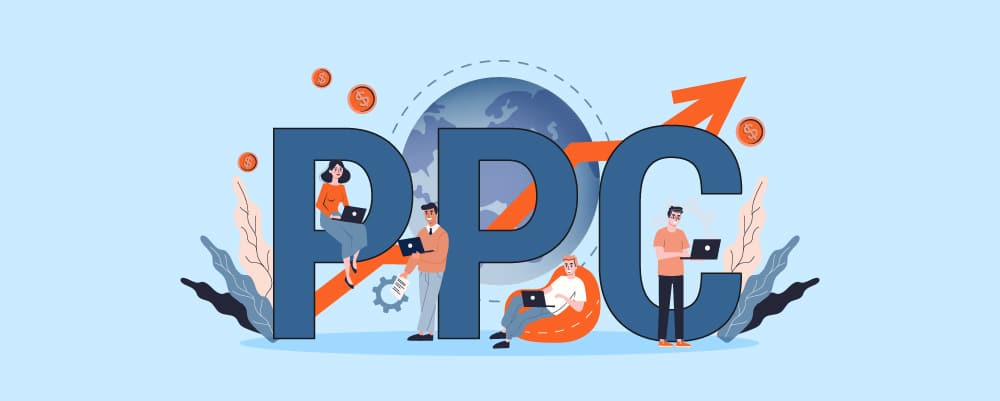Introduction
If you can appreciate step-by-step and highly actionable marketing strategies that can be applied immediately or at a later date, then you’ve come to the right place!
Pay-per-click marketing is a type of online advertising that allows different advertisers to pay a fee every time a user clicks on their ad. These ads can be found anywhere on the internet and, unless you’ve been living under a rock, you’ve encountered them at some point!

Google Ads is also a powerful tool used by businesses looking to promote their products or services through paid advertising. The service allows advertisers to target specific keywords and phrases, and display advertisements on Google Search, Gmail, and YouTube, among many other websites.
But how do you get started with Google Ads? Why is PPC so beneficial?
To find the answer to these questions and a whole lot more, read on to discover a complete guide to PPC marketing with Google Ads.
If your looking for more in depth training be sure to check our write up on the best google ads courses.
Table of Contents
ToggleA Brief Introduction To PPC Marketing

Google Ads uses a pay-per-click (PPC) model that allows marketers to target a specific keyword on Google and make their bids while also competing with others who are targeting this specific keyword. These are maximum bids, or the maximum you’re willing to pay for an ad.
For example, if your maximum bid is $6 and Google determines that your cost per click is $4, then you get that ad placement! If they determine that it’s more than $6, you will not receive the ad placement.
What Is PPC Marketing?
The pay-per-click (PPC) advertising model has been around since the early 90s and has been constantly adapted to fit with the growth of businesses over the years.
It’s an umbrella term that refers to the model of digital advertising where advertisers can place ads on social media platforms, third-party websites, and search engines—paying a fee when the ad is clicked. Often used in conjunction with SEO, PPC is also a way of buying traffic and achieving campaign goals.
Put simply, it’s a type of advertising that enables you to pay a fee to have your website featured on the search engine result page (SERP) when someone types in specific phrases or keywords. It is most commonly used to increase sales, generate leads, and promote brand awareness—but largely concentrates on relevance.
Users will search for specific services, information, and products at any given time. This is where advertisers have the power to show a targeted ad at the moment that the user is making their search. By targeting account structure and settings, advertisers can then run successful PPC campaigns as long as relevance is paramount.
PPC advertising is most common in search engine results pages, like Google or Bing, but is also used on social channels. These ads are the results that you see before and to the right of the organic search results.
How Much Does PPC Marketing Cost?
Before you even consider making a significant advertising investment, you’ll want to know exactly how much it’ll cost you. PPC can sometimes make this complicated because you pay only when you get results (when somebody clicks on your ad). With PPC, however, you have much more control over how much each engaged consumer will cost you.
When a user searches for a certain keyword, Google searches through a list of advertisers for this word and initiates an auction between them. One of the Google algorithms will then select ads based on the quality score of each ad and each advertiser’s maximum bid and
Essentially, PPC marketing isn’t only concerned with the amount that you bid. The quality of your ad plays a huge part as well.
Types Of PPC
These are some of the most common types of PPC advertising that are used to promote businesses:
- Display Advertising-these are image, banner, or text-based ads that appear on different sites, all to target a particular audience. These will then link to your site. They can be very useful for building brand awareness.
- Paid Search Marketing – this allows marketers to pay providers such as Google Ads to create ads for users who search specific keywords. This is text-based and requires the use of relevant keywords to take users to a suitable landing page.
- Remarketing Advertising-these ads are used to target users who have previously paid a quick visit to your website. More information will be provided later in the article.
Important Benefits Of PPC Marketing
If it’s done right, PPC can be effective immediately. That is, you will reach your target audience as soon as your target ads have been approved. If you can create such a seamless user journey then you may see lots of ROI for your efforts!
It’s also a quick way of driving instant traffic to your website. It takes only a short amount of time from when you first learn about PPC marketing to then actively implementing it in a PPC campaign and then driving traffic to a site.
PPC marketing also allows you to be extremely specific about who can see your ads.
Compared to alternatives such as social media, email marketing, or SEO, which can sometimes take years to begin driving traffic, PPC could save you lots of valuable time and energy! It’s also extremely easy to measure and track thanks to tracking pixels, which shows you your costs and overall ad engagement.
The Role Of PPC In Marketing

PPC plays a critical role in the development and branding of businesses, helping to both define and shape them. If you own a business and aren’t doing any PPC marketing within your company then you could potentially be losing out on valued traffic and revenue!
But that’s not all. There are a couple of noteworthy and extremely specific roles that PPC plays in terms of marketing.
Increase Brand Awareness
Regardless of whether you’re a smaller organization or a larger corporation, ensuring brand recognition is a crucial way of guaranteeing success. PPC marketing means that brands can get exposure when users search for particular keywords or phrases that are relevant to the brand and the service or products that they sell.
When it comes to increasing your brand awareness and getting exposure, ensuring that your brand appears in search results for relevant terms is a great way forward.
Retarget Users
Online marketing is both popular and highly effective. As a result, several advertisers are using it to guarantee that they are actively getting the most from their advertising budget.
Retargeting users is one of the most unique advertising strategies that can be implemented. It helps advertisers to retarget key users who may have previously visited their site to entice them into returning.
Regardless of whether they visited the website through internet marketing or not, many PPC networks such as Google and Facebook allow advertisers to set up retargeting campaigns. This allows advertisers to run specific display campaigns that are aimed at getting these visitors to return to their site.
If a business has already invested lots of time, energy, and money in an unsuccessful attempt to get a user on their website, it is cheaper to retarget the same user than sourcing entirely new users. This strategy makes PPC marketing an essential element of any advertiser’s approach to search engine marketing strategy.
Contribute To Business Growth And Achieving Goals
PPC marketing can help you to manage marketing and business goals, varying from e-business sales and right track submission to brand exposure. This makes it an essential tool for any business looking to expand its reach.
Consistent And Quick Traffic
PPC is one of the fastest ad campaigns that a business can run. It’s also a consistent way to achieve massive amounts of traffic regularly. More importantly, PPC is one of the most reliable digital marketing strategies that can be implemented.
It has the potential to bring in huge sales, traffic, and leads. If it is precisely carried out then it could have the potential to bring in the highest possible Return on Investment (ROI).
Only Pay For Clicked Ads
PPC is an easy-to-understand advertising platform that comes without hidden terms and conditions. It is largely how the business that runs the campaign pays the search engine to list the ad at the very top of the page, giving businesses a chance to achieve significant ROI.
Best practice for any PPC campaign includes click fraud detection software. These days Google does a pretty good job of catching competitors clicking on your ads, and doesn’t charge you for this activity. But I must say I’ve seen some pretty elaborate schemes to get clients to blow through their budget.
Complete Control Over Expense
There are many shades in terms of default operation settings, meaning you’ll eventually have full control over a variety of choices when reaching potential clients. This starts with the keywords or placements that you want to target and also depends on how restrained you want to be.
Budget and expense are two of the main criteria that define the direction in which the business is moving towards. By implementing a successful PPC campaign you have control over setting the financial expenses for the advertising campaign and also control the costs. All you need to do is set the budget according to the requirement.
In short, PPC can provide complete support to the business to improve its online visibility. However, it is really important to remember that PPC marketing isn’t a magic tool. It won’t suddenly make your business thrive but will act as a cog in the wheel that is your marketing strategy.
How Campaigns Work With Google Ads

Google is a global resource that receives nearly 6 billion search queries per day. Despite the popularity of the search engine itself, there are many other notable elements associated with Google. This includes the paid advertising Google Ads platform that has existed for almost two decades.
If you’re looking to create a profitable campaign using Google Ads, then follow the below steps.
The Auction System
When a search engine determines that a query has commercial intent and matches the set criteria to appear to a target audience, you will enter an auction. During this time, you are battling with other businesses and competitors who are also gunning after a particular ad slot.
But how is the winner of the auction chosen by Google? Well, there are a few criteria that must be considered. This includes:
- Ad Quality – this is determined by Quality Score (QS) which is a metric employed by Google. It considers expected click-through rates, landing page experience, and ad relevance.
- The Bid – the maximum cash amount that each advertiser eligible for the auction will pay (this could be for a click or another action). Bids can be set at the individual keyword level or at the ad group level.
- Expected Impact – this is from ad formats and ad extensions, which are things that can be added to the initial ad format.
After considering this information, it’s clear that the higher the relevance and written quality of your ads, the less money is required to win an auction.
Google also allows you to use other bidding options such as cost per mille (CPM) which can be used in display campaign auctions.
Ad Group And Ad Hierarchy
Google Ads sets a high standard in terms of ad management systems. Individual ads cannot be made immediately. Instead, each ad must be part of its ad group within a campaign. This allows advertisers like those at Google Ads to efficiently manage the entire ad account, but this depends on the platform that you use.
In Google Ads, you can establish the following:
- Campaign Level – determines the objectives, networks, budget and bidding, ad extensions, languages, and type of campaign.
- Ad Group Level – a grouping of related keywords.
- Ad Level – descriptions, ad headlines, URL, and extensions.
The best thing to do when using Google Ads for a campaign is to decide on a structured plan and then stick firmly with it. For example, some PPC experts will stick to a single keyword per ad group and then make this clear during their naming conventions.
Keyword Matches
Search ads only appear if the search query of the user matches keywords and phrases that advertisers and businesses have previously bid on. Because of this, the sequence of the ads that are displayed on a site is dependent on the results of the auction.
In this situation, you can carry out keyword targeting. This involves you selecting a keyword and then finding a relevant match type—which is often just as important as the keyword is. Some of the most popular match types you may encounter include:
- Broad Matches – this will match you with anything singled out to be relevant. This disregards typos and word order. These aren’t usually suitable unless you’re a large corporation that can bid on millions of search queries all at once.
- Broad Match Modifier (BMM) – this works much as a broad match does. However, in the search query, you must include the +keyword.
- Exact Match – as its name suggests, this will match the keyword exactly regardless if it’s in a singular or plural form. It will also match close synonyms and variants. Using this match type gives you complete control over what you’re bidding on.
- Phrase Match – this is an exact match to the keyword, except there can be additional words before or after the keyword.
Target Audiences Using Google Display Network (GDN)
Google Display Network is a primary channel used by many advertisers to reach potential customers or users. With GDN you can create campaigns based on target ROAS, cost per thousand impressions (CPM), cost per click (CPC), enhanced CPC (eCPC), or target cost per action (TCPA).
Each time a visitor clicks onto google, or types in a particular search query, the search engine can collate data about their activity. This can then be turned into potential targeting methods for many advertisers.
Browsing and search history can also be transformed into affinity audiences which you can then target using your display ads. Affinity categories include banking and finance, entertainment, food, and drinks, or anything else that you frequently search for using the platform.
Unless you have an extremely broad target market then affinity audiences could be a waste of your ad budget. You can find your affinity categories in your account settings However, you may sometimes be shown display ads that have nothing to do with your interests.
To prevent this from happening you can try placement targeting. This is a much more effective way of targeting audiences. Using this method, you can select relevant websites that use Google AdSense Ads.
Excluding Keywords And Placements
PPC campaigns require a certain level of optimization so that there are fewer websites and keywords available to bid on. If you’ve ensured that your campaigns are up and running then checking the auction system and what it’s bidding on is an excellent idea.
Unless you specifically choose exact matches, you might encounter bidding on irrelevant-or less relevant -keywords. Such keywords you choose to exclude from a campaign are commonly referred to as negative keywords. These can be applied at many different levels of the Google Ads account hierarchy.
If you aren’t aiming to just target specific placements in display campaigns, then your ads will likely appear in irrelevant placements. This could mean they end up in spaces that have nothing to do with your business. Removing those that have lots of impressions could save some money in the long run.
Top Tips For Succeeding With Google Ads

Logging into a PPC platform and having to manage campaigns can be difficult. But there are several key tips to successfully and efficiently manage these types of campaigns using Google Ads.
1. Do As You Learn
The most important thing you can do to succeed using Google Ads is to put any information and skills that you learn into practice as soon as possible. This will help you become familiar with the process and will also enable you to develop your confidence. Just remember, there are no secrets – only practice!
There’s also no point in over-consuming large quantities of information on a variety of PPC topics if it’s not necessary or doesn’t serve a purpose. And, much like any other thing in life, there are going to be times when you don’t understand information, or don’t care to consume it for the sake of a single task – and that is completely okay!
2. Take Google Ads Courses
Taking a demo tour is an excellent way to familiarize yourself with PPC platforms. You’ll learn where everything is located, what to set up first, how things work, and will also discover the things that you should pay most attention to. That’s where Google Ads courses come in handy.
Google Ads provides you with a seemingly endless number of learning courses and resources for you to explore. These will provide you with the necessary tools to achieve targeted advertising, guarantee brand exposure, implement spending limitations, and also reach the right people at the right time.
After signing up for a course you may receive help and guidance from a support officer or sales rep at Google. While this is highly convenient, you must also bear in mind that their key goal is to convince you to spend lots more of your money on the service. So proceed with some degree of caution.
One of the best things about PPC is its abundance of guidance and official documentation. Ads are the main generator of significant revenue for technology giants such as Google. This means that they must provide lots of help.
Not only are you provided with plenty of helpful tooltips and hints when utilizing Google Ads, but you will also find that its knowledge base contains a large number of the key things that you’ll be seeking.
3. Start Small
If you do not have a Google Ads account set up and ready to go, Google will do all they can to convince you to create Smart campaigns immediately. This is where you give up a large amount of the general settings and control to the algorithms present on the Google platform.
You should avoid doing this if you can. When you’re starting with PPC, it’s always a much better choice to have all of the necessary tools directly in your hands so you can get used to the process. Then, after you know a little more about what you’re doing, you can begin to incorporate the smart features to further develop your marketing strategy.
The best way to approach your initial campaigns is to start small so that if something goes amiss, you won’t suffer for it. Start creating these campaigns using cheap keywords that remain relevant to the product you’re offering. Sticking with a budget for these smaller things will ensure you stay on track in terms of your marketing budget.
You can also regularly optimize and monitor your campaigns. Keeping track of them is an essential part of ensuring that they are successful. After you begin seeing results, you will be able to gradually introduce a higher volume of relevant keywords.
4. Set Up Conversions And A Way Of Tracking
The next step is to start creating your goals to ensure that you’re keeping tabs on the metrics you need to measure your marketing performance. You can do this by using conversion tracking.
Conversion tracking is a free tool that shows you what happens after a customer has had valuable interaction with your ads. These customer actions (known as conversions) could include downloading your app, signing up for a newsletter, or purchasing a product for themselves. You should set up conversion tracking before you begin the process of advertising.
It should be noted that PPC metrics are always concerned with money. The key aim is to squeeze your advertising spend to get the absolute most out of it. Because of this, Key Performance Indicators (KPIs) must be considered. In this instance, an important KPI will be the cost of each conversion.
It’s crucial to count a conversion whenever a customer buys a product, but you should also count the additional conversion value. It’s still a relatively simple process but you will probably need some help from a developer.
Setting up conversions also gives you the chance to take advantage of Google’s algorithms which can ensure performance optimization.
5. Do Enough Research For Targeting
Having the right data to support targeting choices is critical, whether it’s websites, audiences, or keywords.
With search ads, you must carry out detailed keyword research. You might think that keyword research is only linked to SEO but you couldn’t be more wrong! It’s invaluable for all types of PPC-based search ads.
However, you must first recognize the types of things that people are searching for and also figure out the average amount that you will be paying for all clicks.
You can use PPC keyword research tools such as Google’s Keyword Planner for precise cost-per-click (CPC) numbers. This won’t give you lots of the data that paid PPC tools or SEO tools would. Google Ads will present you with some suggestions for poignant keywords. All you need to do is paste these into your landing page and Google can then do the hard work for you!
This data can also be found in Ahrefs’ Keywords Explorer which is arguably the more reliable keyword research tool. Using this program, all you need to do is key in some seed keywords that capture the product you’re offering, or ones that summarize the business itself, and then move on from there.
More advanced Formats

There is plenty more to PPC marketing. Here are some of the features, targeting options, and ad formats that you must consider using when you’re more familiar and confident with your knowledge of the basics.
Manual And Automatic Ad Extensions
Ad extensions are extra details and links that can show supplemental information about your business (in addition to standard descriptions, URLs, and headlines.) They are an efficient way of extending ads with added functionality, and can also work to increase click-through rates and improve ROI all at the same time.
While there are manual ad extensions that you can run, search engines might also generate their relevant ad extensions. Manual ad extensions give the advertiser the choice to set up and enable the extension themselves, whereas automated extensions involve Goold Ads predicting when certain extensions may begin to improve your ad’s performance, and enabling them automatically.
Whichever ad extension is used, it will serve a purpose for basic PPC ads by enhancing the click-through rate (CTR) of the ad headline. This is because ads are larger and may have more physical prominence on the SERP.
Dynamic Search Ads (DSA)
These are search ads that are shown depending on the content on your website. A Google Ads mechanism will trawl your website to find terms closely related to your site’s content. This then means the landing page and headline can be dynamically generated so that they match the search term.
This also means that you can establish search campaigns that provide several URLs instead of targeting keywords, which allows Google to decide if a particular query poses relevancy to the landing page.
With DSA, you’ll get more use out of a broader target market. If you select a group of keywords to use for a niche audience or product offering, DSAs are unlikely to be helpful as they will target completely unrelated keywords instead.
Remarketing Ad Formats
Remarketing Google Ads is a form of online advertising that enables different websites to showcase targeted ads to individuals that have previously visited their site. These visitors will see customized ads as they scroll through social media, read news sites, browse the web, or even while they are watching YouTube videos.
It’s a highly effective advanced Google Ads format that keeps your brand at the forefront of your audience’s minds, encouraging them to re-visit your site again in the future.
All you need to do is set up a tracking code—a pixel or a tag— that actively works to collect data about all visitors to your website through browser cookies.
This is extremely convenient and can later be used to reach the visitors again using various formats belonging to Google Ads. Essentially, this type of advert is great at transforming undecided visitors into loyal customers.
After some time, you might even be able to create different Google Ads remarketing lists for extremely targeted campaigns; for example, showing users who have previously purchased from your site vastly different adverts than those who haven’t purchased from you before.
Custom Intent Audiences (CIA)
As consumers, we are often bogged down by ads on any website that we visit. These are usually pretty irrelevant to the site we’re exploring and are an attempt by companies to entice us into purchasing or requesting business from them.
To summarise, custom intent audiences are a product of Google that allows marketers and businesses the opportunity to control exactly who sees the ads, all based on the previous online activity of the user.
In essence, it targets individuals that are looking for information about a particular topic or product using the web using YouTube video ad campaigns or display videos. CIA can be defined by URLs or keywords or can be used in combination. The best part? You can select as specific or broad a keyword as you want!
During this process, users will type in particular keywords, watch videos, click through various specific pages, and will later decide to make a purchase.
Summary

And that concludes the complete guide to PPC marketing with Google Ads. As you now know, there is lots of important and relevant information to learn and remember about PPC marketing and Google Ads. Notably, the crucial role they play in terms of promoting specific businesses, products, and services to a wider target audience.
Google Ads plays a crucial role in helping marketers and businesses to reach their audience by formulating ads that target specific groups of people to entice them to either make a purchase or revisit the site.
PPC marketing comes with a whole host of benefits that only serve to increase your visibility online, which is an extremely important part of advertising.

